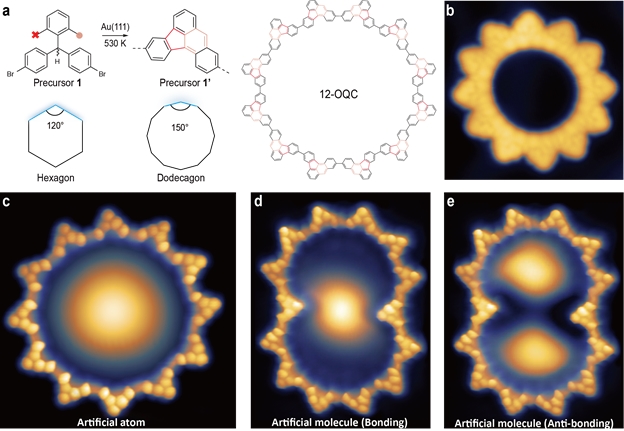
A research team led by Prof Jiong LU from the Department of Chemistry, National University of Singapore (NUS) has devised an on-surface synthetic protocol to construct atomically-precise and stable organic quantum corrals (OQCs), which induce a series of new quantum resonance states.
The team has devised an on-surface synthetic protocol (Figure (a)) for the construction of atomically–precise and covalently linked organic quantum corrals (OQCs) with dimensions comparable to the wavelength of surface electrons (Figure (b)) to meet the needs of quantum materials. Quantum corrals are two-dimensional nanoscale structures, which are formed by positioning individual atoms or molecules in specific arrangements that form closed structures. The protocol allows for the precise engineering of quantum states in OQCs with specific designs, which can be used to control the properties of surface electrons.
The molecular precursors, which are specially designed by Prof Chunyan CHI also from the Department of Chemistry, NUS ensure that the on-surface synthesis results in various OQCs with desired geometries and large dimensions. The research team also used state-of-the-art scanning tunneling microscopy (STM) to directly visualise a series of new quantum resonance states that arise from a collective interference of scattered electron waves inside the nanocavities of the OQCs, corroborated by theoretical studies conducted by Prof Aleksandr RODIN from Yale-NUS College.
The team demonstrated the potential to engineer quantum resonance states in open OQCs, which is achieved by the manipulation of the organic structure using the STM tip. This technique opens up opportunities for engineering desired quantum resonance states in chemically robust OQCs for specific quantum applications.
Prof Lu said, “Our work opens up a new avenue for the fabrication of robust large-sized OQCs with well-defined geometries for the exploration of designer quantum states and their electronic coupling in novel quantum architectures. Atomically-precise and covalently-linked OQCs synthesized in this work are technologically alluring as they offer both high chemical stability and digital fidelity required for on-chip quantum device operation.” Read the full story here.
